In 2024, the **foldable smartphone market** is advancing swiftly. Samsung has now introduced the sixth iteration of its foldable flagship, enhancing the design it initially brought to the forefront. Google has made its second attempt at foldable technology with the **Pixel 9 Pro Fold**. Both devices are packed with impressive specifications, refined aesthetics, and advanced AI capabilities. However, with their premium pricing, which one should you choose? After using both smartphones for just over a week, I will provide a detailed comparison of the **Pixel 9 Pro Fold** versus the **Galaxy Z Fold 6**, focusing on essential aspects such as design, display, performance, and user experience.
Pixel 9 Pro Fold vs Galaxy Z Fold 6: Specs at a Glance
| Specifications | Pixel 9 Pro Fold | Samsung Galaxy Z Fold 6 |
|---|---|---|
| Processor | Google Tensor G4 (4 nm) | Qualcomm Snapdragon 8 Gen 3 (4 nm) |
| RAM/Storage | 16 GB RAM + 256 GB UFS 4.0 Storage | 12 GB RAM + 256/512/1 TB UFS 4.0 Storage |
| Cover Display | 6.3 inches, Full HD+ (1080 x 2424) 120 Hz OLED, Corning Gorilla Glass Victus 2, HDR | 6.3 inches, HD+ (968 x 2376) 120 Hz Dynamic LTPO AMOLED, Corning Gorilla Glass Victus 2, HDR |
| Inner Display | 8.0 inches, 2076 x 2152, 120 Hz Foldable OLED, HDR 10+ | 7.6 inches, 2160 x 1856, 120 Hz Foldable OLED, HDR 10+ |
| Rear Camera | 48 MP Main + 10.5 MP Ultra-wide + 10.8 5x Telephoto | 50 MP Main + 12 MP Ultra-wide + 10 MP 3x Telephoto |
| Cover Display Camera | 10 MP Selfie camera | 10 MP Selfie camera |
| Inner Display Camera | 10 MP camera | 4 MP in-display camera |
| Video | Up to 4K at 60 FPS, 10 Bit | Up to 8K at 30 FPS, 4K at 60 FPS, HDR10+ |
| Connectivity | 5G, Wi-Fi 7, Bluetooth 5.3, NFC | 5G, Wi-Fi 6E, Bluetooth 5.3, NFC |
| Port | USB Type C 3.2 | USB Type C 3.2 |
| Battery | 4,650 mAh | 4,400 mAh |
| Charging | 45-Watt fast wired charging, 23-Watt wireless charging (with Google 45-Watt Charger) | 25-Watt fast wired charging, 15-Watt wireless charging |
| IP Rating | IPX8 | IP48 |
| Software | Android with 7 years of OS updates | Android with 4 years of OS updates |
What’s Inside the Box?

The unboxing experience is consistent with what is typically expected from both Samsung and Google. You will find the phone, a USB Type C charging cable, and essential documentation—similar to previous offerings from both brands. I personally prefer Samsung’s packaging over Google’s more eco-friendly design, which utilizes recycled materials.
Pixel 9 Pro Fold vs Galaxy Z Fold 6: Build and Design
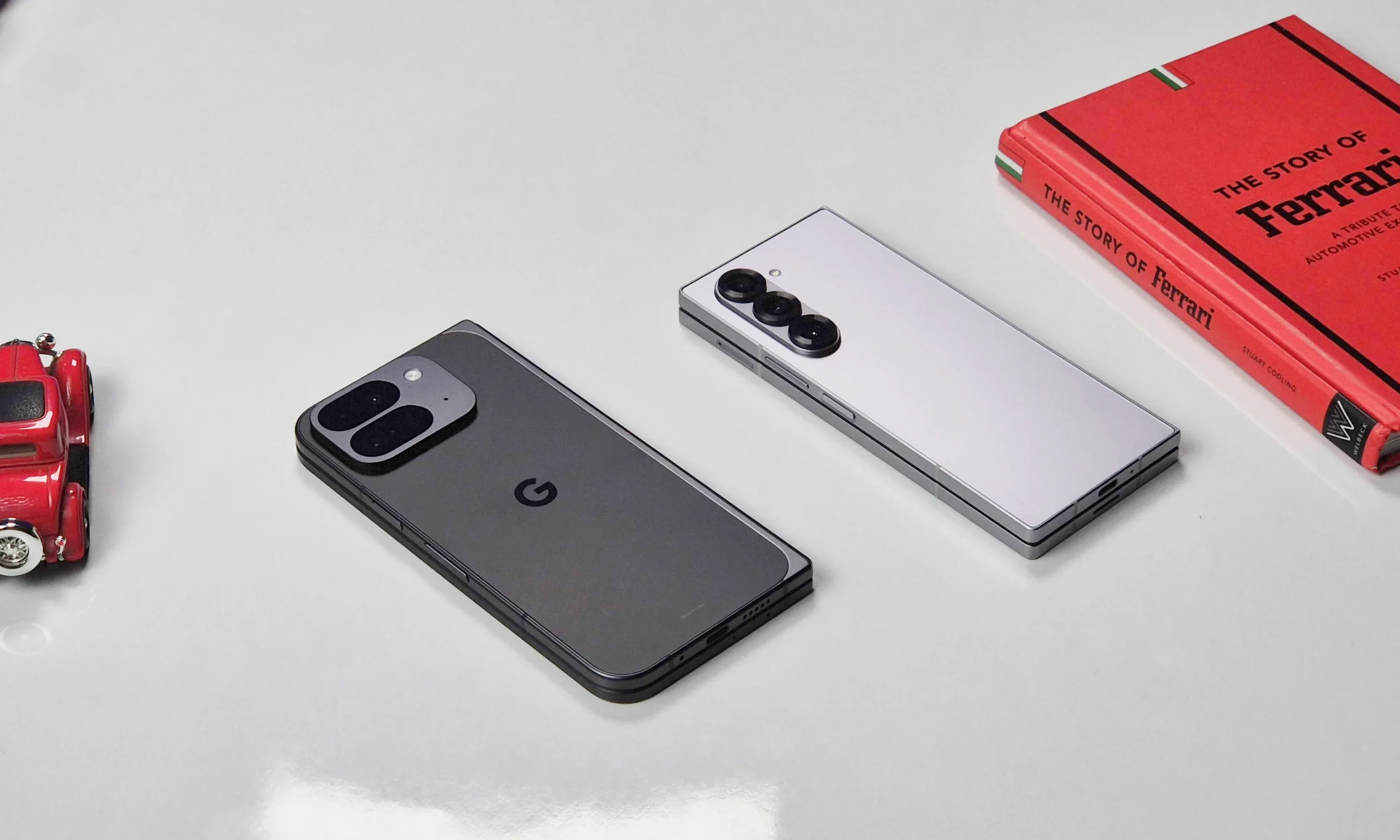
The Pixel 9 Pro Fold marks a shift from the **passport-style design** of the original Pixel Fold, adopting a more conventional smartphone shape. On the other hand, the Z Fold 6 retains a narrower form that can feel like holding a candy bar, although it can be less comfortable to use the cover display due to its cramped layout.
Interestingly, the 9 Pro Fold is among the **thinnest foldables available**, measuring just 10.5mm when folded compared to the 12.1mm of the Z Fold 6. It also features more rounded edges, making it more comfortable to hold for extended periods. However, I’m not particularly fond of the extended sides housing the hinge, as they give the device an odd look owing to the contrasting corner designs. A similar approach is taken by the OnePlus Open, albeit in a less pronounced manner.
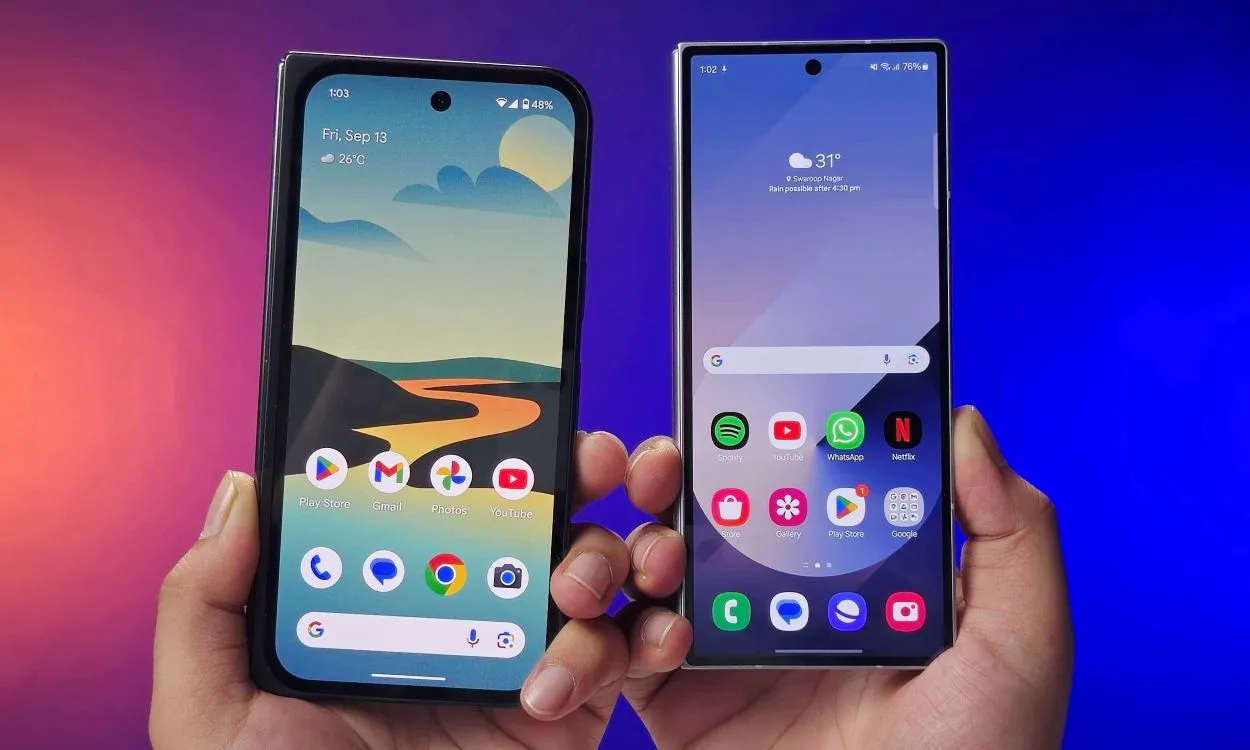
Conversely, the Z Fold 6 showcases a sleek design that reflects years of evolution in foldable technology. The **symmetrical design**, featuring flat sides and sharp edges, gives it a polished and professional look that appeals to many users. Notably, my colleague pointed out that the Pixel 9 Pro Fold can be challenging to unfold, unlike the easily operable Galaxy Z Fold 6, thanks to the design of their respective grooves.
Both devices embed the fingerprint sensor within the power button. Finding the sensor on the Pixel was relatively easy, although it can be somewhat slow, necessitating multiple attempts for proper recognition. In contrast, the Z Fold’s flush power button sometimes makes it challenging to locate, especially without a case.
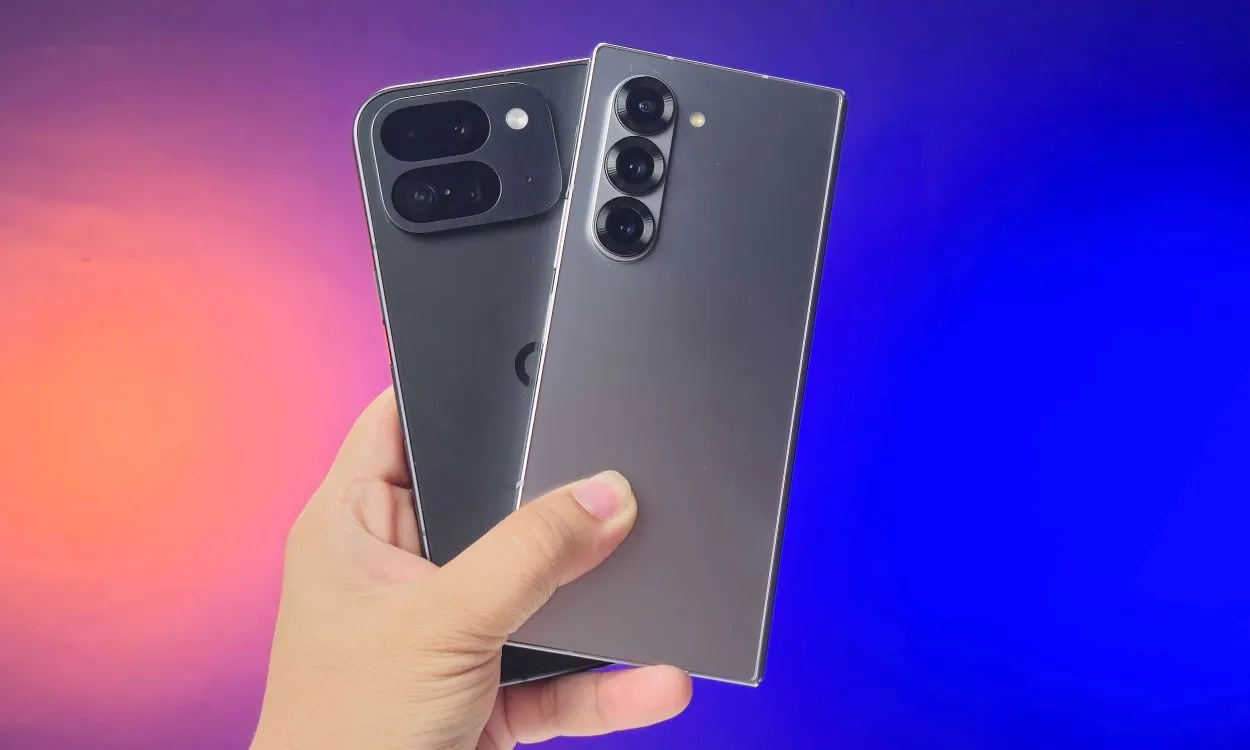
The camera bump on the Samsung device is vertically positioned on one side, causing it to wobble when placed on flat surfaces—a trait that the Pixel shares, leading to a missed opportunity to adopt a more stable design.

When unfolded, the Pixel 9 Pro Fold extends to 8 inches, whereas the Z Fold 6 maxes out at 7.6 inches. A standout feature of the Pixel is that it can lay completely flat, minimizing the appearance of creases—a trait that quickly becomes familiar. Both devices that I tested feature robust hinges that allow for stable positioning in various degrees of fold. However, I found the Samsung model to be more enjoyable in daily usage.
Overall, I prefer the Pixel’s larger form factor to that of Samsung’s, as it aligns closely with the vision we had for foldable phones back in 2018. Google has improved significantly with this iteration. While there are minor design flaws, they do not overshadow the overall positive experience. Samsung’s design is notably elegant, and while I appreciated it, I never quite experienced the satisfaction of having two screens simultaneously as I did with the Pixel.
Winner: Pixel 9 Pro Fold
Display and Speakers: The Bigger the Better
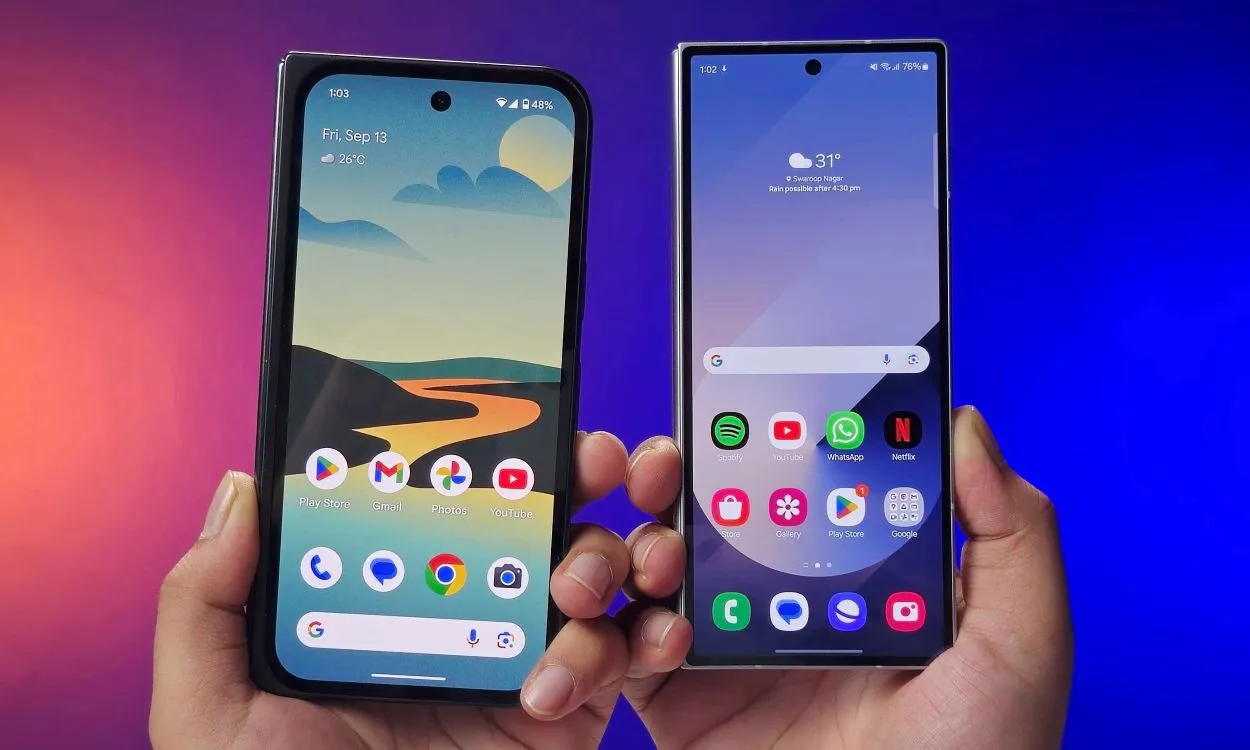
Both models feature a **6.3-inch** cover screen, but the Pixel 9 Pro Fold utilizes a 20:9 (1080 x 2424) Full HD+ OLED display. In contrast, Samsung employs a lower-resolution HD+ LTPO AMOLED display. Notably, both support a 120 Hz refresh rate; however, the LTPO functionality in the Samsung model contributes to better battery efficiency. Additionally, both displays are fortified with **Corning Gorilla Glass Victus** for added durability against scratches and drops.
The inner display of the Pixel measures **8 inches** (2076 x 2152), while Samsung’s is a **7.6 inches** (2160 x 1856) foldable AMOLED. Unlike their cover panels, both inner displays benefit from LTPO alongside a 120 Hz refresh rate. Samsung’s screen also supports S Pen functionality, enhancing usability.
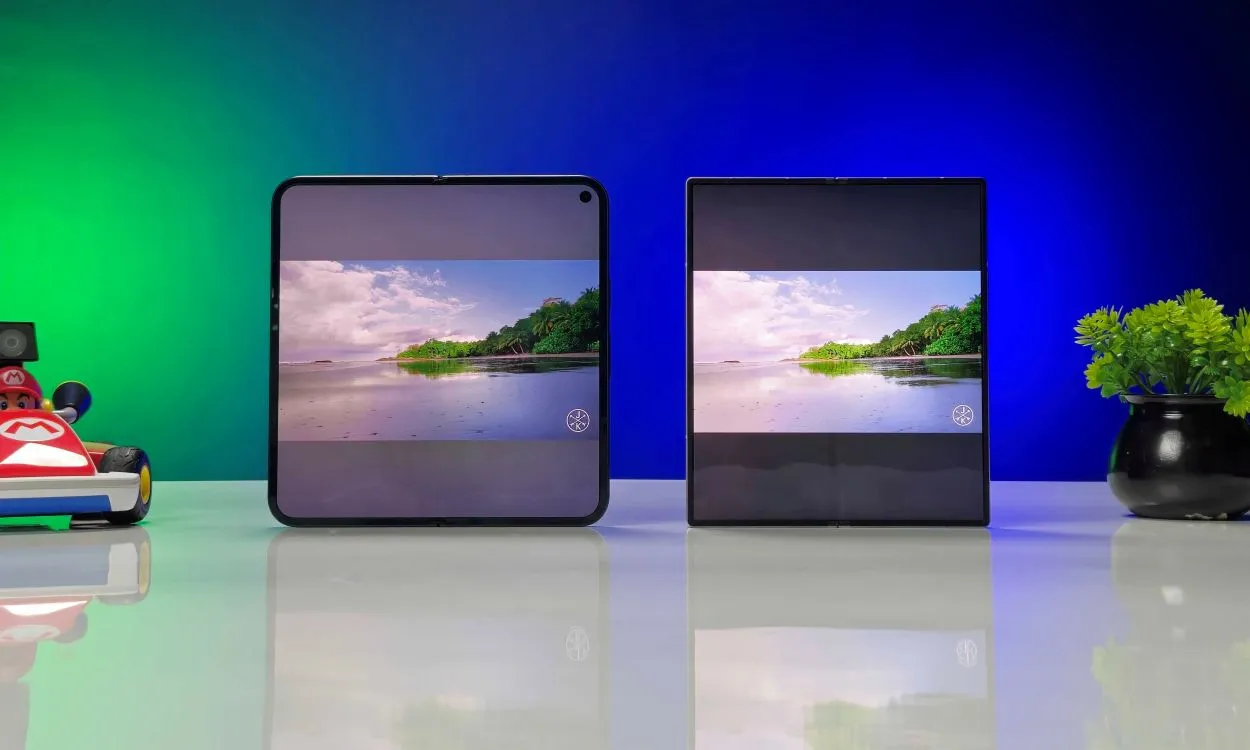
When using both devices, the **Z Fold 6** appeared more vivid and vibrant, while the **Pixel** displayed a more balanced color tone. The 9 Pro Fold features a Natural color setting that can wash out all colors, so sticking with the default option is advisable.
During regular usage, I frequently found the need to fully open the Samsung Z Fold 6. Its narrow cover display felt too constricted for swiping and typing. Although I adapted over time, my instinct when texting, watching videos, or browsing social media was to unfold it.
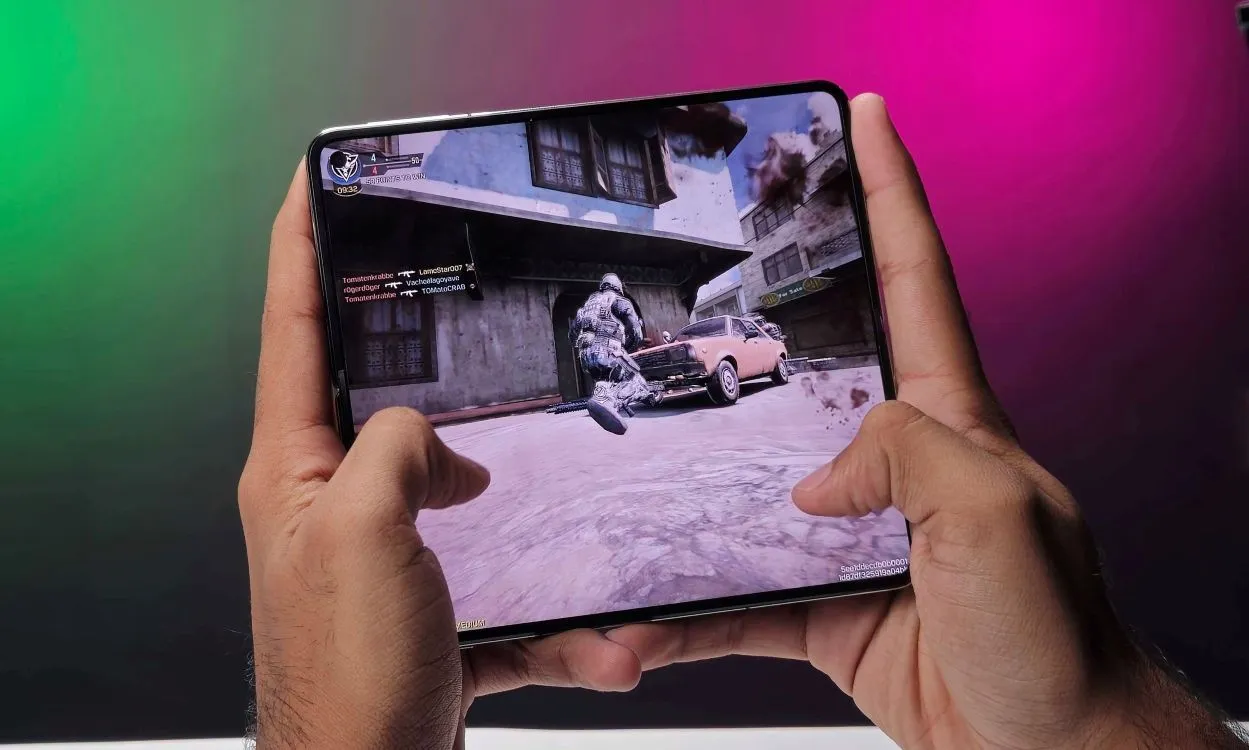
In contrast, the Pixel 9 Pro Fold’s conventional cover screen made it suitable for most tasks without needing to access the inner display. I primarily reserved the larger screen for multitasking tasks, such as reading articles or comparing prices across grocery delivery apps, along with gaming. The enhanced display size offers a premier gaming experience for titles like Call of Duty: Mobile and Fall Guys.
Brightness levels are comparable between both devices, with the Pixel being marginally less bright on the outer display. Overall, the **Pixel 9 Pro Fold** emerges as the victor in this round.
Winner: Pixel 9 Pro Fold
Software Experience: Where the Cracks Start to Appear

The Pixel 9 Pro Fold operates on **Pixel UI**, while the Galaxy Z Fold 6 utilizes **One UI 6.1.1**, both built atop **Android 14**. While it may seem that the stock Pixel UI would surpass Samsung’s One UI, my hands-on experience proves otherwise. Both devices deliver a fluid and responsive user interface.
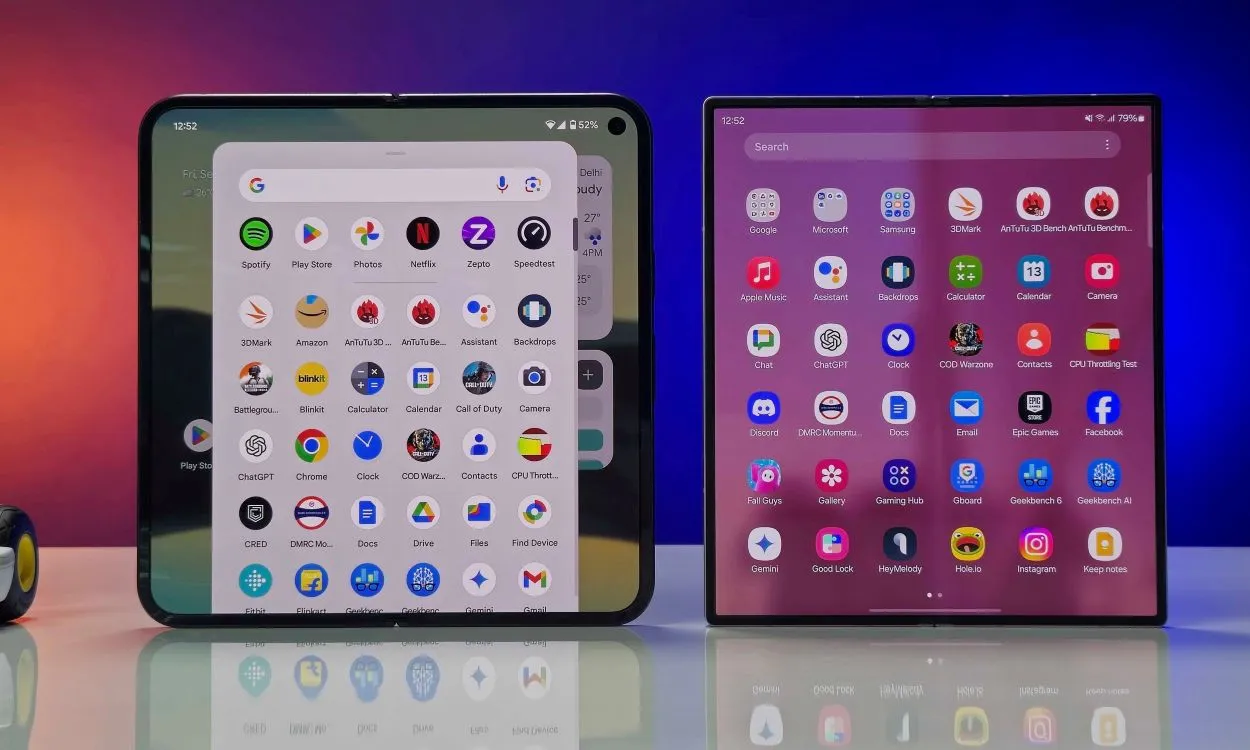
Nevertheless, the overall functionality of the **Pixel 9 Pro Fold** leaves room for improvement. While it’s not inherently flawed, a few areas require updates. For example, the app drawer does not properly blur the background as expected. Various apps struggle with resizing on large screens, while some may not function at all.
Specific apps may overlap the gesture control panel, leading to occasional application crashes, including two instances of UI failure. The multitasking feature, limited to running two apps side by side, has similar challenges, particularly when switching orientation.


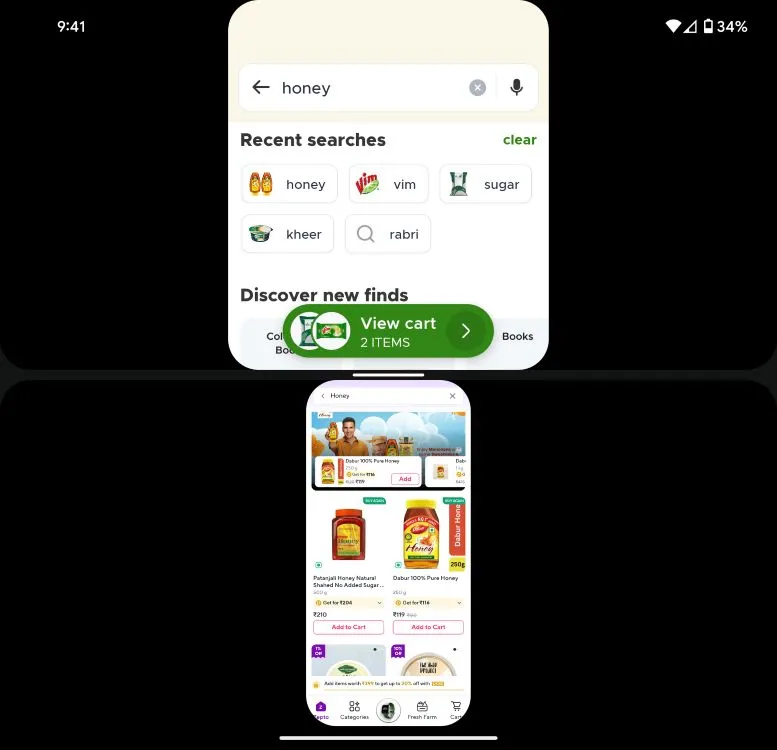
In contrast, I did not encounter these inconsistencies within Samsung’s **One UI**. My experience on that device was satisfactory, featuring a robust set of multitasking capabilities—like floating windows, running multiple applications simultaneously, creating app pairs, and customizing their placement. The **S Pen support** further enhances the appeal, allowing for note-taking or sketching at will. This polished experience starkly contrasts what I encountered on the Pixel.
Both smartphones feature a variety of AI capabilities; however, I found little utility in them given my previous exposures to AI this year.
Finally, by opting for Samsung, you can expect up to **four years of major software updates**. Meanwhile, Google promises nearly **seven years of support** for the Pixel 9 Pro Fold, showcasing their commitment to long-term device usability.
Winner: Samsung Galaxy Z Fold 6
Pixel 9 Pro Fold vs Galaxy Z Fold 6: Performance
The **Pixel 9 Pro Fold** is powered by Google’s Tensor G4 chipset, built on a 4nm architecture, while the **Samsung Galaxy Z Fold 6** packs the impressive Qualcomm Snapdragon 8 Gen 3 processor, also utilizing 4nm technology. The Pixel comes equipped with **16 GB RAM**, surpassing Samsung’s **12 GB**, with both handsets starting at 256 GB of storage capacity. Let’s delve into how these devices perform.
Benchmarks
I conducted standard benchmarking tests on both foldables, and the outcomes are detailed below.
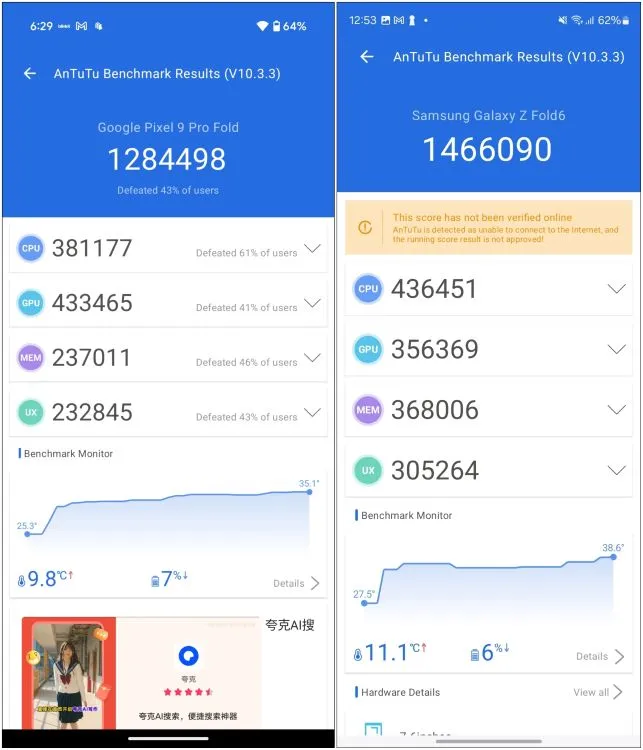
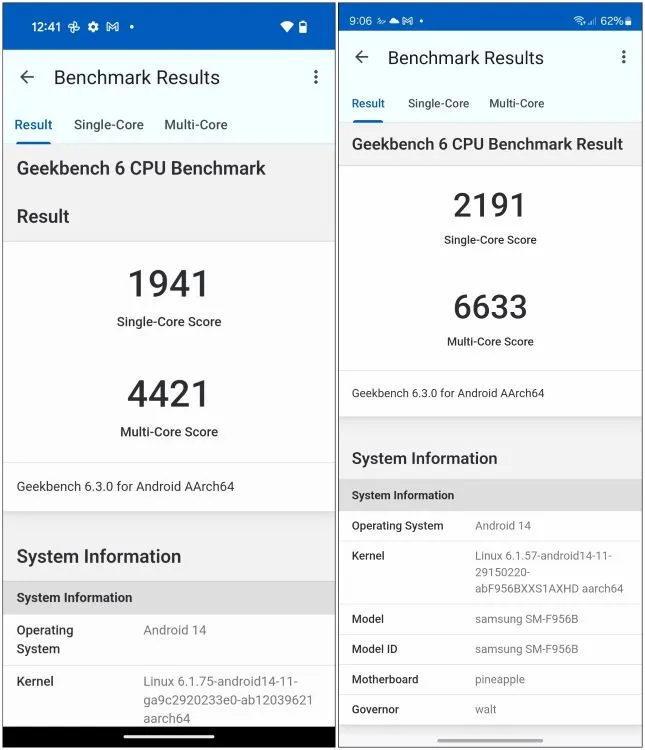
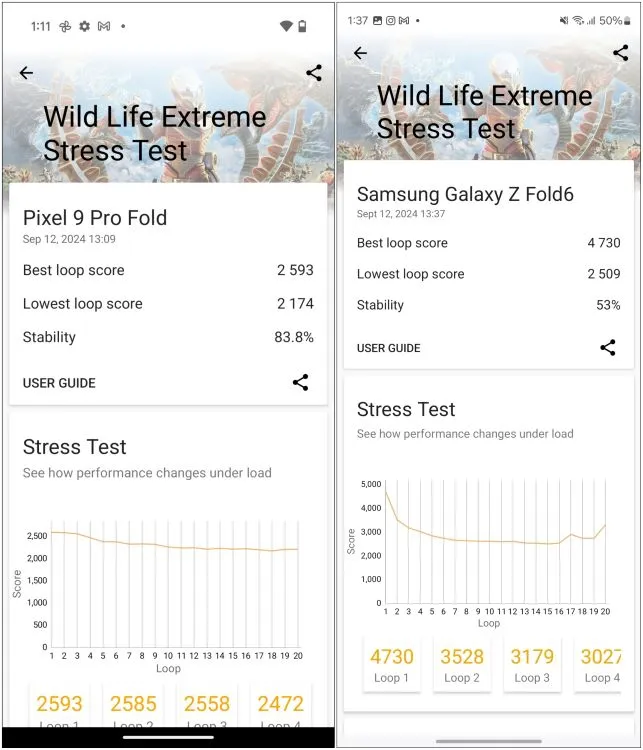
Day-to-Day Usage
As previously noted in the software segment, both devices deliver a smooth user experience. Opening applications, multitasking, and navigating social media are virtually seamless.
While the **Tensor G4 processor** is not as robust as the Snapdragon, it remains competent, showing no sluggishness during extensive use with applications like **Instagram** and **YouTube** running concurrently with messaging apps.
The same can be said for the Samsung; however, it does exhibit somewhat aggressive memory management, often requiring apps to reload after closing in the background.
Gaming
| Games | Pixel 9 Pro Fold (Settings & FPS) | Galaxy Z Fold 6 (Settings & FPS) |
|---|---|---|
| Genshin Impact | Medium + 60 FPS (48-50 FPS), High + 60 FPS (40-45 FPS) | Medium + 60 FPS (57-60 FPS), High + 60 FPS (53-58 FPS) |
| CoD Mobile | Very High + Max (60 FPS), Low + Ultra (120 FPS in Multiplayer/90 FPS in Battle Royale) | Very High + Max (60 FPS), Low + Ultra (120 FPS in Multiplayer/90 FPS in Battle Royale) |
| 1. BGMI | Ultra HDR + Ultra Smooth + Extreme (55-60 FPS) | Ultra HDR + Ultra Smooth + Extreme (60 FPS) |
| Warzone Mobile | Medium Graphics + Uncapped FPS (around 52 FPS), High graphics mode not available | High Graphics + Uncapped (stable 60 FPS mostly) |
Despite concerns about its performance based on prior experiences with the **Tensor G4**, it manages to handle gaming effectively, maintaining about **50 FPS** in Genshin Impact—no small feat. The **Z Fold 6**, however, surpasses it, managing demanding titles with fluidity thanks to the Snapdragon 8 Gen 3.
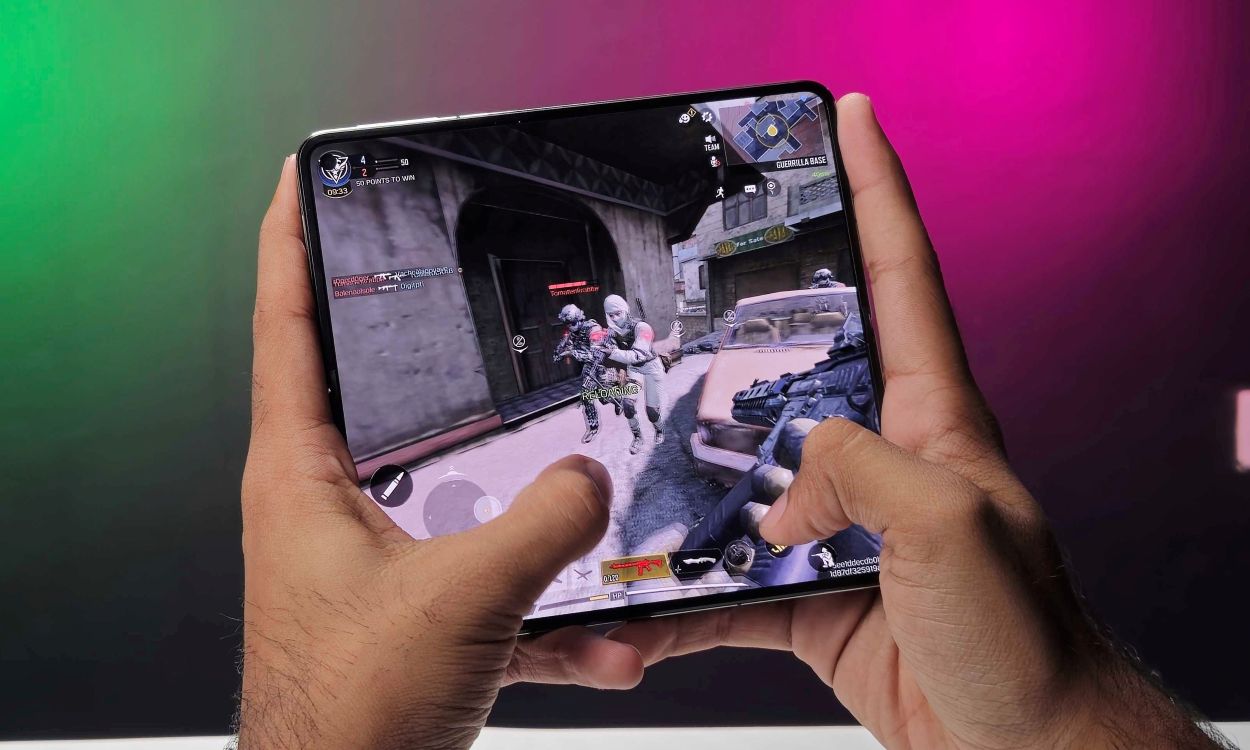
Pixel 9 Pro Fold vs Galaxy Z Fold 6: Camera
Each smartphone is engineered with a triple camera system at the rear and dual selfie cameras—one embedded on the cover and another positioned within the foldable display. The **Pixel 9 Pro Fold** features a **48 MP main camera**, **10.5 MP ultra-wide**, and a **10.8 MP 5x telephoto lens**, while the **Samsung Galaxy Z Fold 6** sports a **50 MP main lens**, a **12 MP ultra-wide**, and a **10 MP 3x telephoto sensor**.
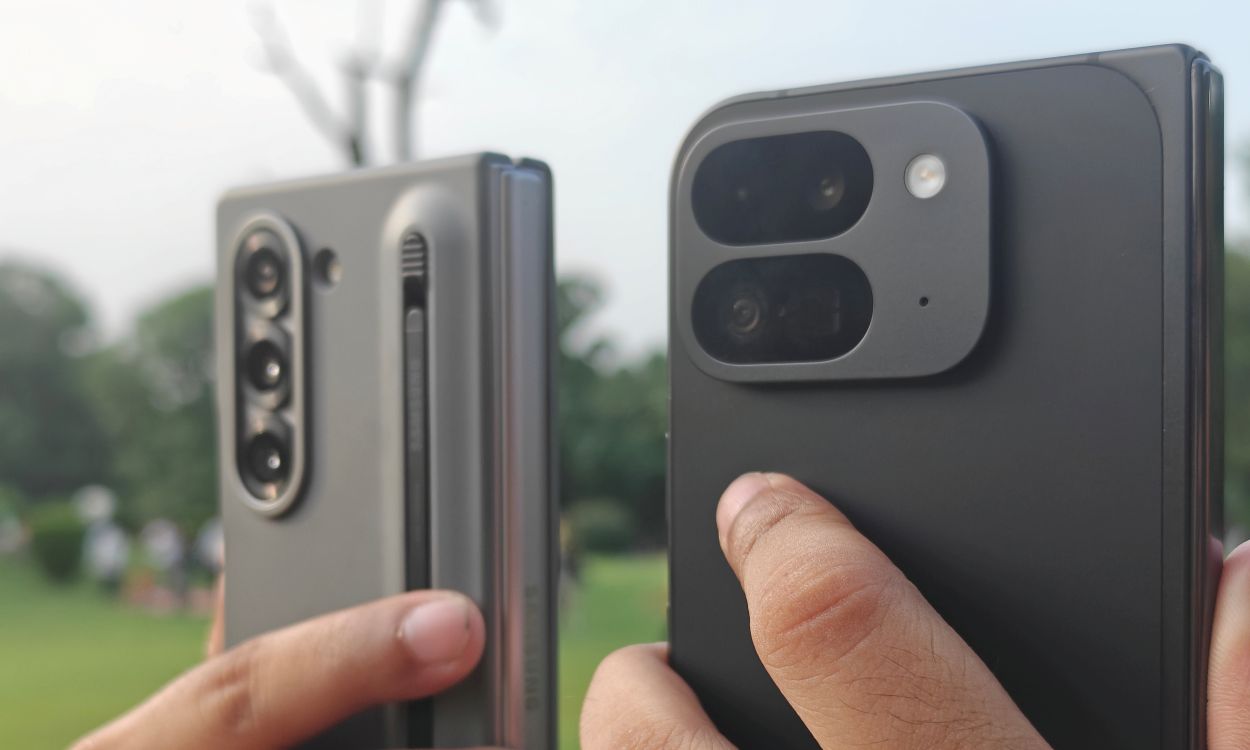
During a weekend trip to Lodi Garden in Delhi, I pitted their camera capabilities against one another.
Day Time
In daylight, both devices capture remarkably good images, exhibiting ample detail. However, user testing shows that Samsung often excels in shadow preservation, whereas the Pixel performs better in other scenarios. Samsung tends toward cool and saturated colors, while the Pixel tends to present a more natural representation.
Despite this, Samsung sometimes struggles with overly bright exposures in direct sunlight, while the **Pixel** occasionally lacks detail, particularly in wider shots where Samsung can capture more due to its broader sensor.
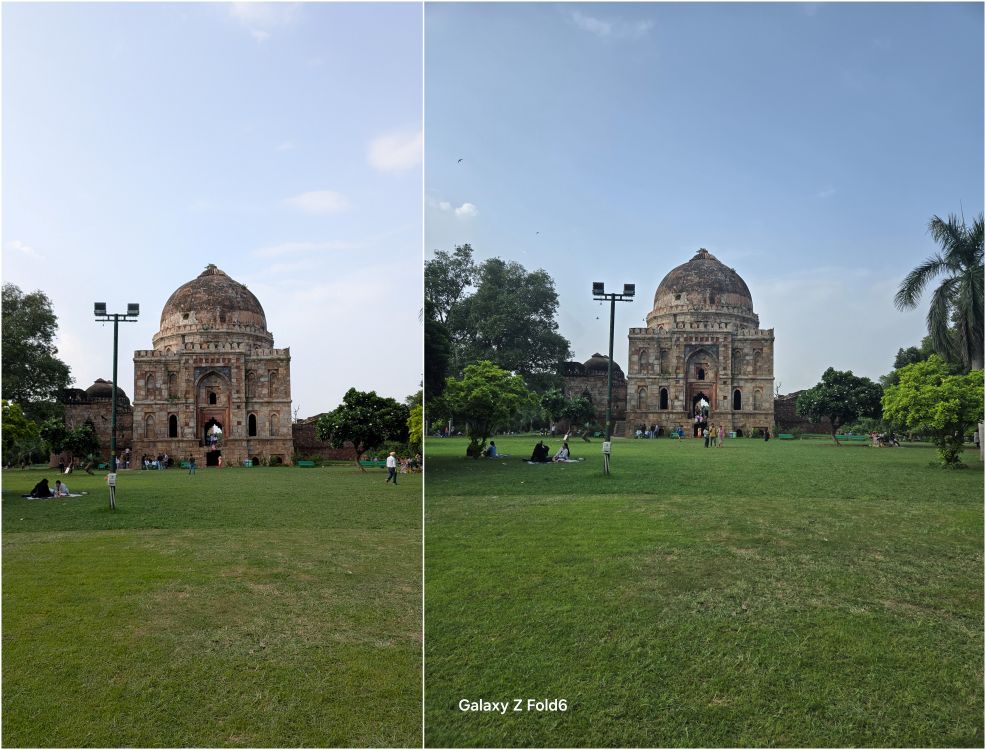

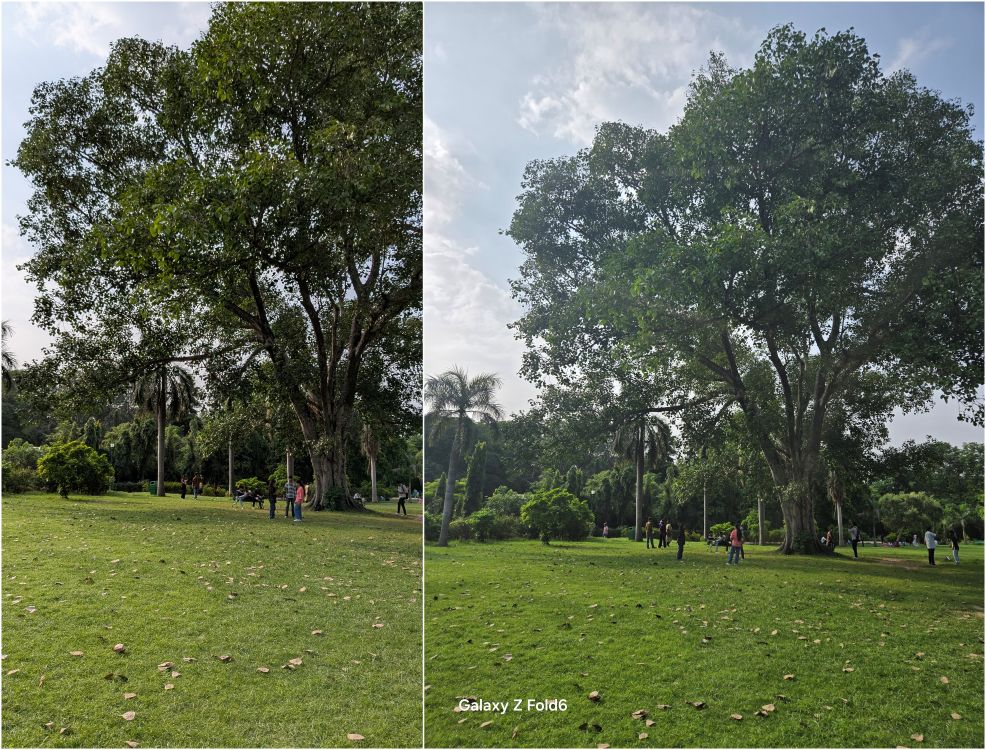
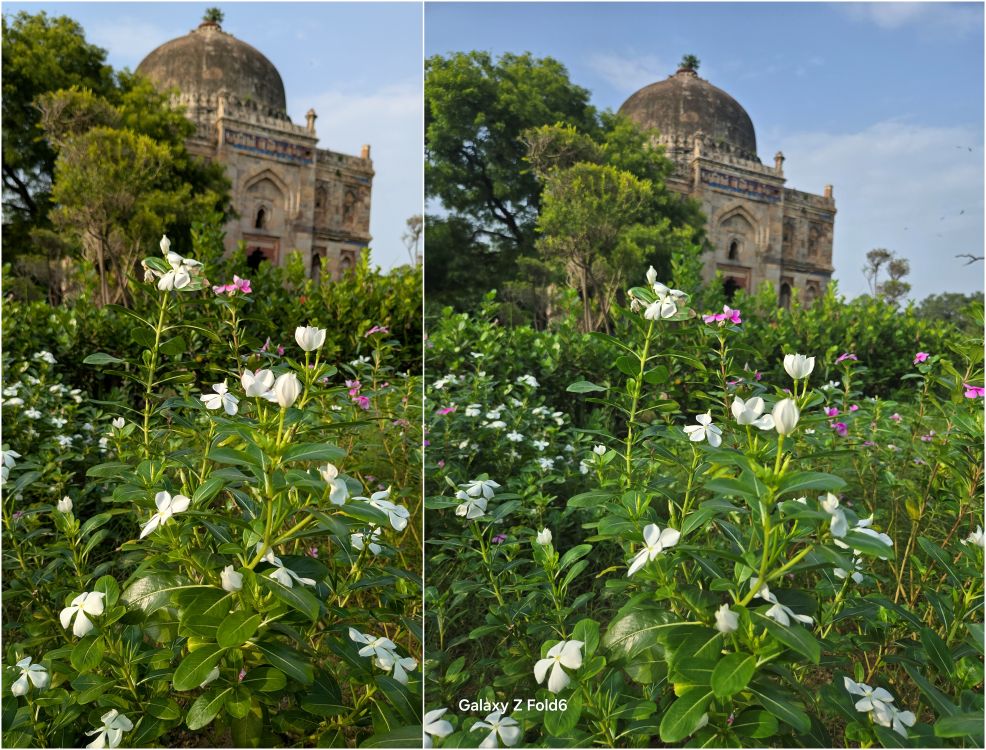

Ultra Wide Shots
These devices showcase near-equal ultra-wide capabilities, although the **Pixel’s 127-degree** ultra-wide lens captures a more expansive scene than Samsung’s **123-degree** sensor. Both smartphones deliver sharp and vibrant images, though Samsung’s photos typically offer more brilliance, despite a narrower field.
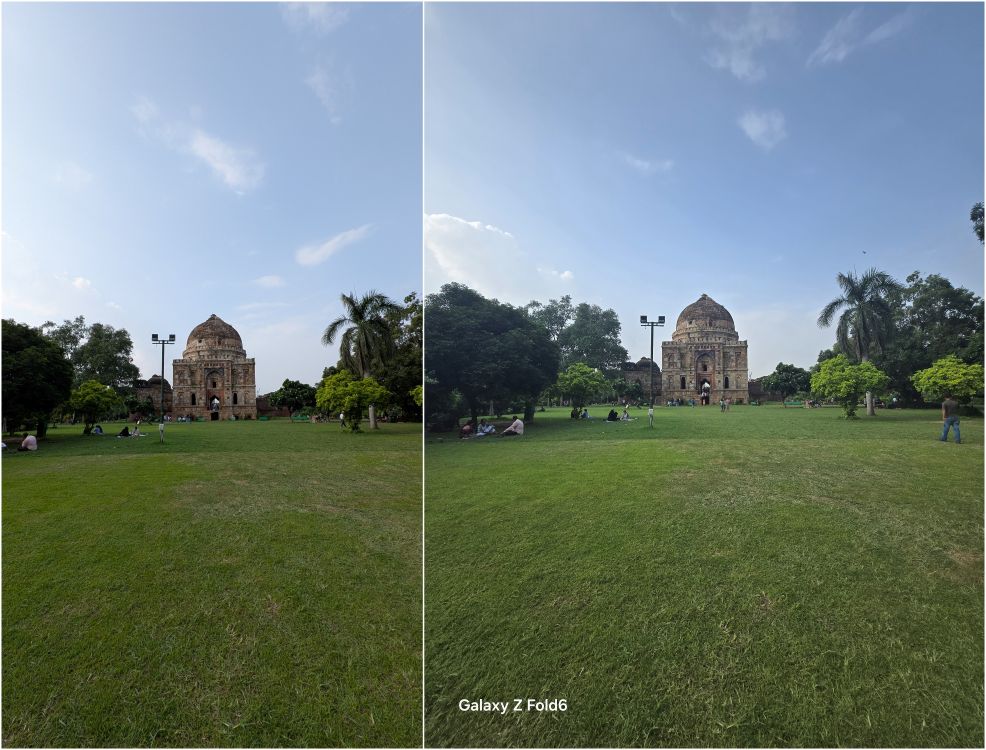
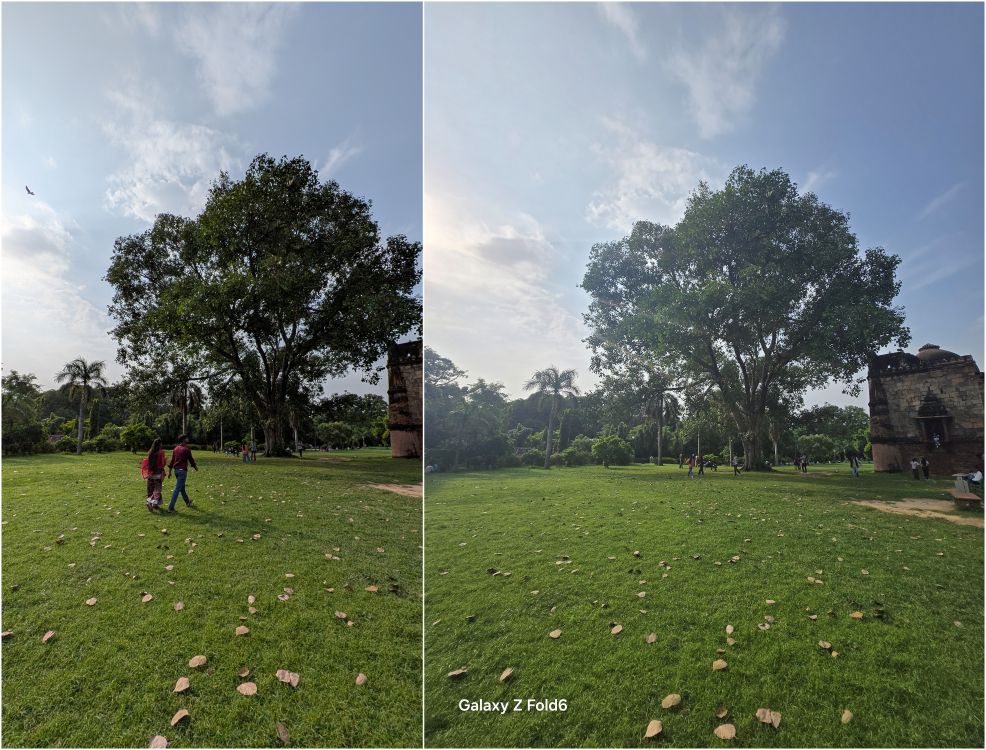
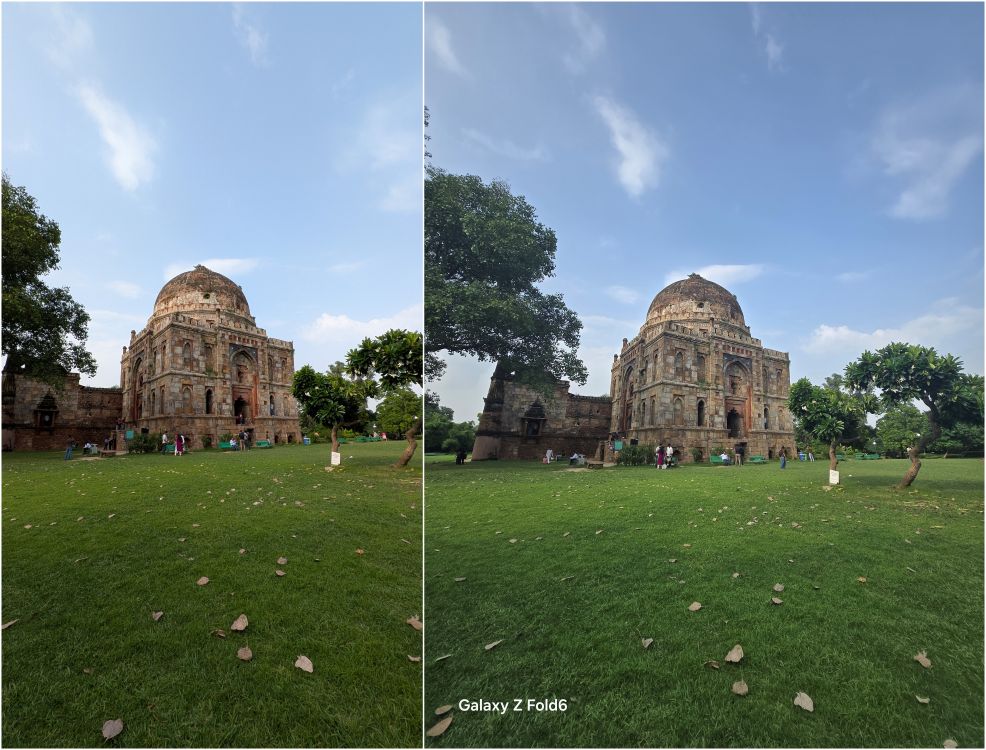

Night Time
As night falls, the performance tips in favor of the Pixel, which excels at retaining detail and minimizing grain in low-light situations. Conversely, while the Galaxy Z Fold 6 is competent in low light, it struggles with shadows, resulting in slightly fuzzier images.





Selfies
For selfies, both devices sport a **10 MP sensor** on their covers, but Samsung clearly delivers better results. The Pixel 9 Pro applies a smoothing effect, even with beautification features turned off, leading to photos that feel overly manipulated. Samsung captures more natural and genuine selfies, although it suffers from a washed-out background.


Portrait shots mirror this pattern. While Google effectively blurs backgrounds, issues persist with the selfie quality. The Pixel’s bokeh effect remains more natural than what Samsung’s camera produces, which tends to appear overly dramatic.
The Z Fold 6 features a **4 MP under-display camera** for selfies, which, while innovative, is primarily effective for video calls. The 9 Pro Fold’s **10 MP** lens outperforms it but both inner cameras are relatively comparable.
Videos
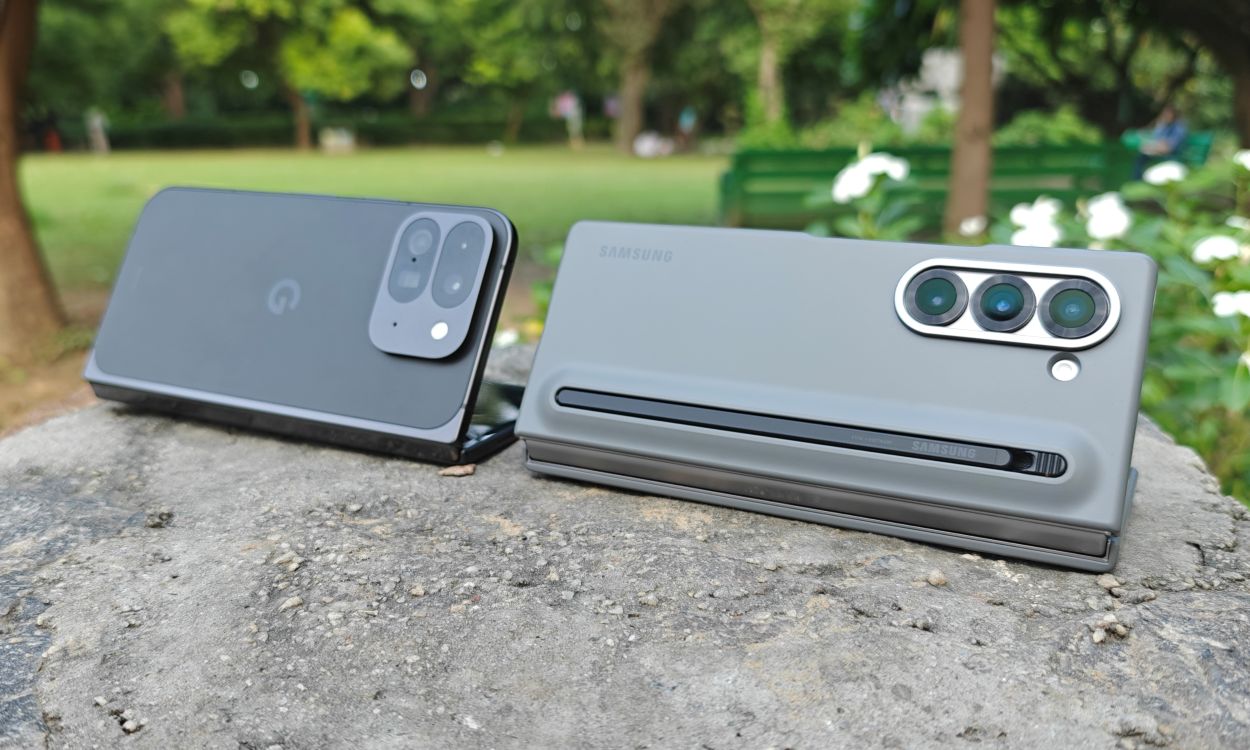
In video recording capabilities, the 9 Pro Fold can capture **4K video at 60 FPS**, while the Z Fold 6 can record up to **8K at 30 FPS**. Both devices boast OIS technology to enhance stability during recording, resulting in satisfactory footage quality.
Battery Life and Charging
The **Pixel 9 Pro Fold** houses a **4,650 mAh** battery, marginally larger than the **4,400 mAh** capacity of the Galaxy Z Fold 6. During testing with both phones connected to **Jio 5G and Wi-Fi at my workplace**, I discovered similar screen-on times of approximately **6.5 hours** for both devices, with the Pixel edging out with an additional **3–5%** better performance.
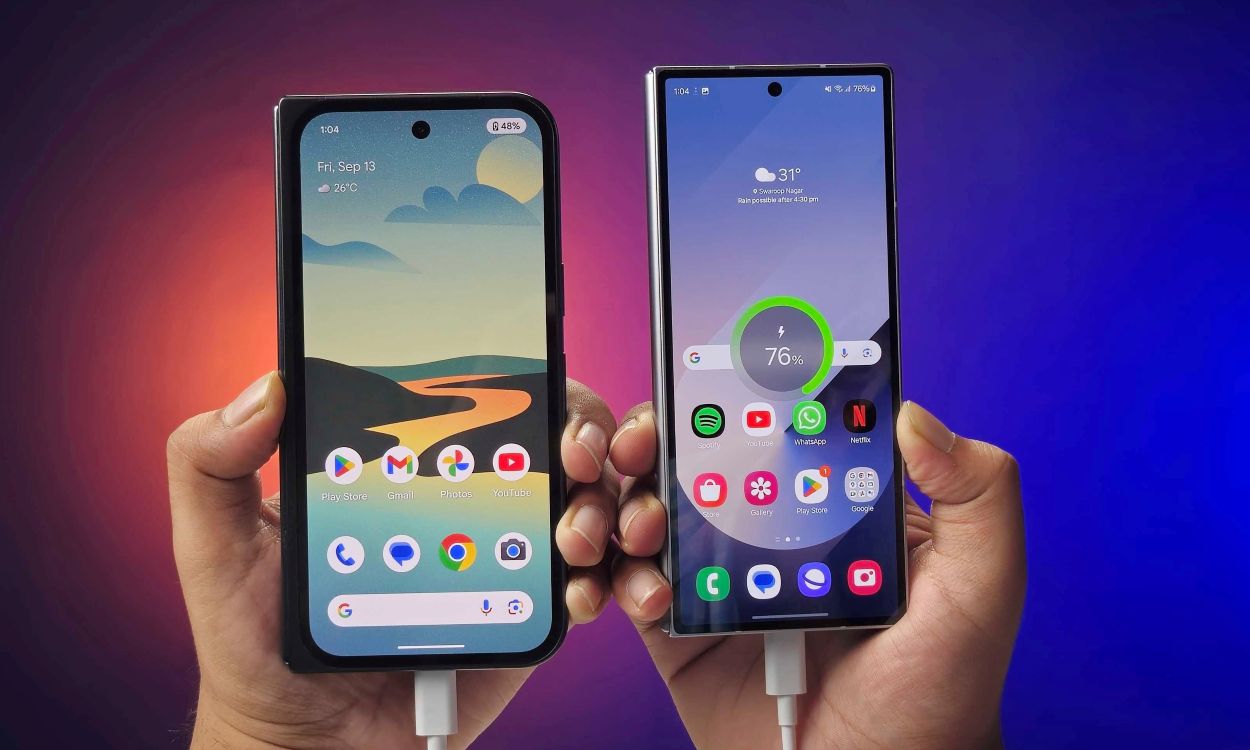
As for charging, the Pixel 9 Pro Fold supports **21 watts wired charging** and **7.5 watts wireless**. In comparison, the Galaxy Z Fold 6 boasts **25 watts wired charging** and **15 watts wireless charging**. With competitors like the OnePlus Open offering fast charging at **67 watts**, you may question why these brands have settled for slower rates.
Which One Should You Buy? Pixel or Samsung
The **Pixel 9 Pro Fold** exemplifies a commendable upgrade over its predecessor, despite certain areas needing improvements, particularly within the camera and software experience realms. Nonetheless, it is fair to say that this smartphone meets expectations with its hardware—I’m curious to see how it performs in the long run.
On the other hand, **Samsung remains a leader** in craftsmanship and user experience, presenting reliable camera performance. However, their design feels somewhat dated. Although the structure makes the phone compact and manageable, the cover display sometimes proves impractical.
If you’re seeking exceptional build quality, superb user experience, and commendable camera results, I recommend the **Samsung Galaxy Z Fold 6**. Conversely, if you’re after a more immersive foldable experience without strongly minding a few drawbacks, consider the **Google Pixel 9 Pro Fold**.




Leave a Reply